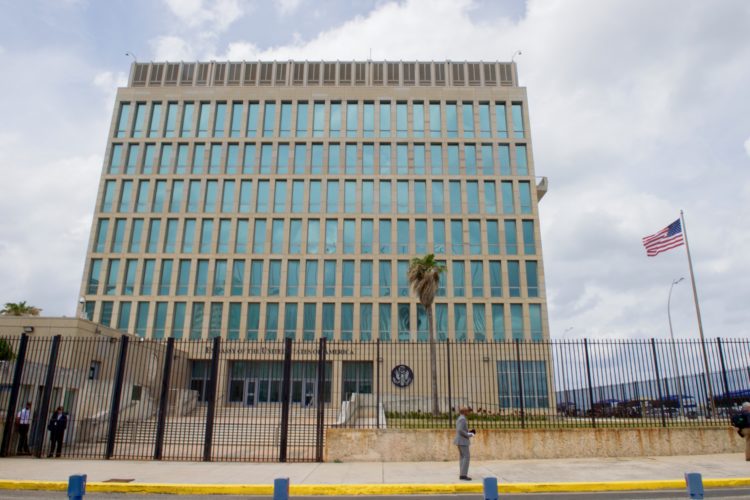Recorded sounds that plagued U.S. diplomats in Cuba just crickets hard at work
Berkeley graduate student Alexander Stubbs matched the recording made by U.S. Embassy staffers in Havana to the Indies short-tailed cricket, an insect with a special sound
January 10, 2019

Alexander Stubbs, here doing field work in Indonesia, credits having done similar work in the Caribbean for his being able to identify the mystery sounds from Cuba in 2016 as being from crickets (Photos: Alexander Stubbs)
In all the noise that comprises our national news landscape these days, noise itself doesn’t often rise to the level of news.
That changed in 2016 when U.S. diplomats stationed in Cuba in October repeatedly reported hearing high-pitched sounds that were followed by hearing loss and other medical symptoms.
Fears arose that the Americans might be under some sort of sonic attack by persons or countries unknown. It was a big story, but over time it got lost in other news noise.
That ended this month when the noise ratcheted up. At the annual meeting of the Society for Integrative and Comparative Biology, UC Berkeley integrative biology Ph.D. student Alexander Stubbs and Prof. Fernando Montealegre-Zapata of the University of Lincoln in the U.K. put forward a study of a recording of the mysterious sounds and posted a preprint to the online repository bioRxive.
Their determination: the high pitch heard by the diplomats was produced by the Indies short-tailed cricket (Anurogryllus celerinictus).
It was a conclusion quickly picked up and highlighted in a New York Times article and zipped around the internet.
Stubbs and Montealegre-Z do not address the medical problems reported by the diplomats in their study; they just pointed out that the noise linked to those medical issues was, in fact, crickets.
“We are showing this recording is in no way dangerous,” Stubbs says. “These sounds may have nothing to do with these people. The whole narrative originally was sonic attacks and loud sounds with acute symptoms.”

In 2016 the U.S. Embassy in Havana was struck by mysterious loud sounds, recordings of which show the sounds to have come from crickets. (State Department photo)
Politically, 2016 was a big time in Cuba. The Obama administration had opened the U.S. embassy in Havana just a year earlier. In part because of the noise and health issues, U.S. Secretary of State Rex Tillerson greatly reduced the embassy’s staffing after the Trump administration took over in 2017. With personnel getting sick, and mysteriously so, the working hypothesis pointed toward some kind of sonic weapon.
One study published in the Journal of the American Medical Association reported that 20 embassy staffers showed signs of concussion, including cognitive deficiencies, and the study suggested a “directed energy” attack might have been responsible. This interpretation of the evidence is hotly debated in the medical community, however, and other researchers have suggested that psychogenic illness is more likely to blame.
One common thread in the staffers’ reports was a loud, piercing sound, which was recorded by U.S. personnel stationed in Cuba. A series of these recordings were analyzed by the U.S. government and given to both the Associated Press and the Cuban government.
There were investigations, both on the American and Cuban sides, and it was a major news story. But the source of the noise couldn’t be pinned down. The Associated Press put one of the recordings on the internet for all to hear, advising that the sound wasn’t believed to be dangerous if listened to in a short burst.
One hypothesis that made its way to the Daily Beast suggested that malfunctioning spy gizmos might be to blame for this sound while the New York Times had experts suggesting futuristic microwave weapons. The Cubans suggested the Jamaican field cricket (Gryllus assimilis), but its call sounds little like the recording released by the AP.
Stubbs, a grad student in professor Jimmy McGuire’s lab in the Museum of Vertebrate Zoology at Berkeley, does intensive fieldwork on reptiles and amphibians in tropical environments under McGuire’s guidance. And it was because of that fieldwork that Stubbs, after listening to the recording released by the AP, says, “It is the time I spent in the field as a Berkeley student both as an undergraduate and as a graduate student that made me think I had heard something like this before.”
Using the Singing Insects of North America database put together by Tom Walker at the University of Florida, Stubbs identified the culprit as the Indies short-tailed cricket, based on a match of the power spectrum of this species with the recording released by that AP.
Despite that match, the pulse structure of the AP recording did not match any of the field recordings in Walker’s database. The breakthrough, Stubbs says, came when he realized the difference could be accounted for by the fact that the recording was made near buildings or indoors. Near a structure, sound pulses would be reflected, creating echoes that would obscure the cricket’s typical sound pattern. When he played the A. celerinictus call on a speaker indoors, it was a nearly perfect match with the recording the U.S. diplomats made in Cuba. The Indies short-tail cricket is common on Grand Cayman, an island where Stubbs has spent time researching lizards for his project on reptilian vision.

Alexander Stubbs
Stubbs then collaborated with Montealegre-Z in the U.K. to show that the recording had a characteristic frequency drop over each sound pulse that matches the detailed biomechanics of cricket calls. It is this frequency drop in each sound pulse that most conclusively shows this recording is of a cricket, and not any other artificial or natural source, he says.
Asked how they can be so sure that the species identified in their report is really correct, Stubbs says, “No other known continuously calling cricket has a wing stroke rate of 180 per second. We can definitively say this recording is of a cricket, and we are pretty sure we know what species it is.”
After last Friday’s New York Times story, Stubbs has been interviewed by the BBC’s World Service, Newsweek and the Canadian Broadcasting Corporation’s As It Happens program. Among others. On Monday, Stubbs had a list of 150 emails from various media organizations asking for comment.
“It is amazing how much interest has been generated just from our preprint,” Stubbs said, adding “but we look forward to having it published in a peer-reviewed journal shortly.”
Amazingly, as pointed out in a recent article in The Atlantic, this is but one instance of biological phenomena causing people concern. In the Bay Area, the “Sausalito hum” that famously disturbed residents of houseboats in the North Bay in the 1980s was found to be the amorous call of the toadfish. The 1981 “yellow rain” incident came about when the United States accused the Soviet Union of providing communist fighters in Southeast Asia with chemical weapons that were later found to be the feces of giant bees.
“I really hope that this, the Sausalito hum and the yellow rain debacle serve as reminders that understanding our natural and biological world serves a useful purpose for humanity,” says Stubbs.
What was it, then, that produced the medical symptoms? Stubbs says he does not know. He does know a cricket didn’t do the damage. And he hopes this study can inform the dialogue going forward.
The study is making noise.